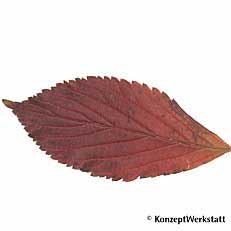Bodnant Viburnum (Viburnum x bodnantense)
The Bodnant Viburnum is a popular fragrant, flowering shrub for kitchen gardens, cultivated from the variety viburnum grandiflorum. Its special feature: it is the first and last flowering shrub to be visited by insects, as it flowers very early and very late in the year.
-
Erscheinungsbild
The Bodnant Viburnum is a popular fragrant, flowering shrub for kitchen gardens, cultivated from the variety viburnum grandiflorum. Its special feature: it is the first and last flowering shrub to be visited by insects, as it flowers very early and very late in the year.
-
Blätter
Obovate to lanceolate pointed leaves 5 - 10 cm long, 2 - 4 cm wide. Leaf stalk 1 - 3 cm long. Dentate margins. Opposite leaves are dark green above, pale green and slightly hairy below, with arcuate feathery veining. Red to deep purple autumn colouring.
-
Blatt Oberseite
Obovate to lanceolate pointed leaves 5 - 10 cm long, 2 - 4 cm wide. Leaf stalk 1 - 3 cm long. Dentate margins. Opposite leaves are dark green above, pale green and slightly hairy below, with arcuate feathery veining. Red to deep purple autumn colouring.
-
Blatt Unterseite
Obovate to lanceolate pointed leaves 5 - 10 cm long, 2 - 4 cm wide. Leaf stalk 1 - 3 cm long. Dentate margins. Opposite leaves are dark green above, pale green and slightly hairy below, with arcuate feathery veining. Red to deep purple autumn colouring.
-
Blatt Herbst

Obovate to lanceolate pointed leaves 5 - 10 cm long, 2 - 4 cm wide. Leaf stalk 1 - 3 cm long. Dentate margins. Opposite leaves are dark green above, pale green and slightly hairy below, with arcuate feathery veining. Red to deep purple autumn colouring.
-
Blüten
Flowering period: XI to III. White, strongly fragrant blossoms, deep pink buds, approx. 1 cm wide. Inflorescence: clusters 5 - 7 cm wide, particularly decorative, flower in November, even at subzero temperatures.
-
Rinde
Dark brown or grey-brown outer bark, occasionally peeling when older. Dark brown branches.
Giftigkeit
Berries, leaves and bark are poisonous.
Anwendung
Flowering shrubs, gardens, container plants, solitary plants, grouped plants, parks
Heimatgebiete
Germany, Europe
Standortparameter
Light: full sun to semi-shady, sufficiently frost- and fume-hardy; soil: fresh to moist; stagnant moisture: to be avoided; soil structure: well aerated, on sandy-loamy to loamy-clayey soil; soil depth: deep; compaction: to be avoided; soil quality: medium to high; nutrient concentration: poor to high; pH value: acid to alkaline.
Ansprüche
Heat-loving, requires protection in winter and well aerated, deep soil. Sufficiently frost and fume-hardy. Soil compaction and stagnant moisture must be avoided.
unknown
Height of growth and spread: 2 m to 3 m. Fast-growing upright decorative shrub.
Blätter
Obovate to lanceolate pointed leaves 5 - 10 cm long, 2 - 4 cm wide. Leaf stalk 1 - 3 cm long. Dentate margins. Opposite leaves are dark green above, pale green and slightly hairy below, with arcuate feathery veining. Red to deep purple autumn colouring.
Blüten
Flowering period: XI to III. White, strongly fragrant blossoms, deep pink buds, approx. 1 cm wide. Inflorescence: clusters 5 - 7 cm wide, particularly decorative, flower in November, even at subzero temperatures.
Früchte
Dark blue, inconspicuous stone fruit.
Rinde
Dark brown or grey-brown outer bark, occasionally peeling when older. Dark brown branches.
Wurzel
Shallow-rooting.






